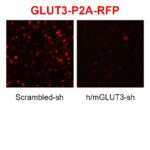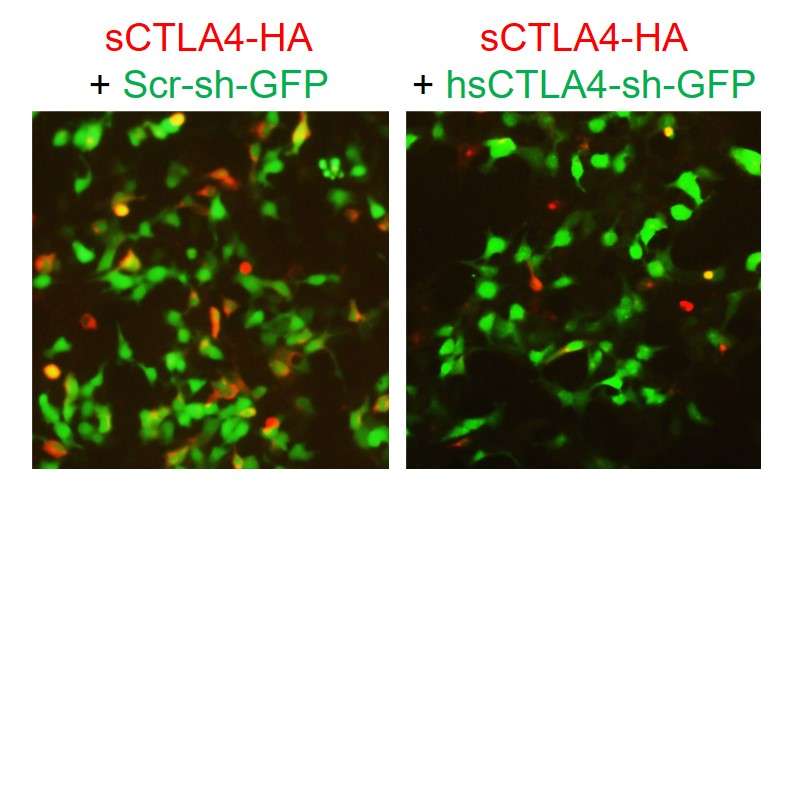-
Previous

h/m NRP2 shRNA Lentivirus
$595.00 – $1,195.00
-
Next

h/m GLUT3 shRNA Lentivirus
$595.00 – $1,195.00
Human sCTLA4 shRNA Lentivirus
$595.00
Validated soluble CTLA-4 (sCTLA4) shRNA lentivirus: High-titer shRNA lentiviral particles specific for human soluble cytotoxic T-lymphocyte associated antigen 4 (sCTLA4, CD152). The shRNA has been validated to meet or exceed 70% sCTLA4 knockdown efficiency using a specific fluorescence-based method that is more rapid and reliable than qPCR. The shRNA lentivirus is ultra-purified and concentrated to high-titer by PEG precipitation and sucrose gradient centrifugation, and ideal for transducing difficult-to-transfect cells including thawed and/or primary cells.
Available Options:
Specifications
Key Advantages:
- Same Cost For Custom Lentivirus – You can receive any combination of reporter (GFP/RFP/Luc/None) and selection marker (puromycin/blasticidin) for this product, without additional cost, by contacting us. To view our complete list of shRNA vectors, click here.
- Superior knockdown – LipExoGen Validated shRNA Lentiviruses are produced using the third generation system and feature novel, optimized shRNA vectors which express a 19-20 bp shRNA, fluorescent (GFP or RFP) or luminescent (luciferase) reporter, and drug-selection marker (puromycin or blasticidin). Taking advantage of a proprietary prediction algorithm developed in-house, validated shRNA constructs are capable of delivering 70% or more knockdown efficiency with less off-target effects compared to longer or mixed-sequence shRNA/siRNAs.
- Superior validation – All of our pre-made shRNA constructs are validated in-house using a specific fluorescence-based method that is more reliable than traditional qPCR. The validation process leverages bicistronic expression of the target mRNA and fluorescent reporter to confirm the efficacy of the shRNA. As knockdown validation can be readout using basic fluorescence microscopy, this low-cost, streamlined approach allows us to provide a superior-quality product at a price comparable or less than the average competitor.
- Superior accuracy – Polyclonal shRNA-transduced stable cells can be established within 10 days and used for downstream applications while preserving more properties of the parental cells. In this way, high-efficiency knockdown from our validated shRNA lentiviral particles can be advantageous over sgRNA CRISPR-Cas9 systems which select for single cell clones.
- Easily identify transduced cells – Validated shRNA constructs contain both fluorescent reporter and drug selection marker, allowing the flexibility to select transduced cells by puromycin/blasticidin or FACS sorting of GFP/RFP. Luciferase reporters are also available for detecting transduced cells in vitro or in vivo using luminescence-based techniques.
Product Data

Figure 1. Knockdown validation for hsCTLA4-sh-GFP-Puro. HEK293FT cells were co-transfected with human soluble CTLA-4 expression plasmid (sCTLA4-HA) and plasmids for indicated shRNAs (GFP). After 24-36 hours, HA tag was stained with Alexa-594 and visualized along with GFP. GFP indicates transfection by the shRNA construct, whereas Alexa-594 stain indicates sCTLA4 protein. Higher knockdown efficiencies may be possible in stably-transfected cells. Scr-sh, scrambled shRNA.
Details
| LSV-0046 | |
| sCTLA4 | |
| cytotoxic T-lymphocyte associated protein 4 (soluble) | |
| NM_001037631.3 | |
| Human |
Recommended Control
Scrambled shRNA Control Lentivirus (mix of two independent shRNAs), Scr-sh-GFP-Puro (LSV-0024-2S)
Custom Orders
If you require a modification to one of our products (for example, change in reporter or other vector component), please request a custom order. We provide a variety of fast and efficient services for the production of high-quality, custom lentiviral particles on demand, usually for the same or comparable price as the listed item.
Or, send us your cells and we will establish a stable shRNA cell line for you using this product. Learn more.
The cDNA lentivirus corresponding to this product is also available upon request, comparable price.
I want to:
Additional Information
Additional Information
| CTLA4 | |
| cytotoxic T-lymphocyte associated protein 4 | |
| n | NM_001037631.3 |
| Homo sapiens | |
| Alias | CD; GSE; GRD4; ALPS5; CD152; CTLA-4; IDDM12; CELIAC3 |
| Annotation Page | https://www.ncbi.nlm.nih.gov/nuccore/NM_001037631.3 |
| Gene IDs | HGNC:HGNC:2505 Ensembl:ENSG00000163599 MIM:123890 |
| Entrez Gene Summary | “This gene is a member of the immunoglobulin superfamily and encodes a protein which transmits an inhibitory signal to T cells. The protein contains a V domain, a transmembrane domain, and a cytoplasmic tail. Alternate transcriptional splice variants, encoding different isoforms, have been characterized. The membrane-bound isoform functions as a homodimer interconnected by a disulfide bond, while the soluble isoform functions as a monomer. Mutations in this gene have been associated with insulin-dependent diabetes mellitus, Graves disease, Hashimoto thyroiditis, celiac disease, systemic lupus erythematosus, thyroid-associated orbitopathy, and other autoimmune diseases. [provided by RefSeq, Jul 2008].Transcript Variant: This variant (2) lacks an exon in the coding region, which results in a frameshift and an early stop codon, compared to variant 1. The encoded isoform CTLA-4delTM (also known as sCTLA4) is soluble and lacks the transmembrane domain, compared to isoform a. The exon skip represented in this variant is is based on human U90273.1, and is consistent with mouse U90270.1 and the data published in PMID:10831323 and PMID:10556814.” |

